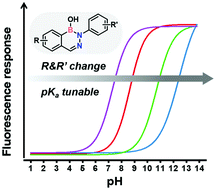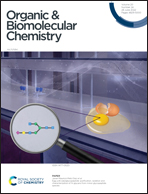Investigation of a benzodiazaborine library to identify new pH-responsive fluorophores†
Abstract
The detection of pH is important owing to its significance in various processes, such as clinical and industrial processes. Numerous fluorescent pH probes have been developed using a variety of fluorophores; however, most are only suitable for application in a narrow pH range (between 5 and 8) owing to the lack of diversity of the pH-sensitive units. Furthermore, probes suitable for sensing high pHs have rarely been studied despite the importance of reliable detection of high pH in various industrial processes. In this study, we prepared a benzodiazaborine (bDAB) library consisting of 238 different bDABs through combinatorial synthesis to investigate their suitability as fluorescent pH probes. Informed by the results of a fluorescence-based, high-throughput screening of the library, we identified four bDABs that exhibit promising pH-sensitive ratiometric fluorescence responses. Their pKas vary significantly, ranging from 7.29 to 12.44, indicating their suitability for the detection of basic pHs even in extremely basic environments (pH > 10). Furthermore, their fluorescence responses show high stability, anti-interference, and reversibility under various pH conditions.



 Please wait while we load your content...
Please wait while we load your content...